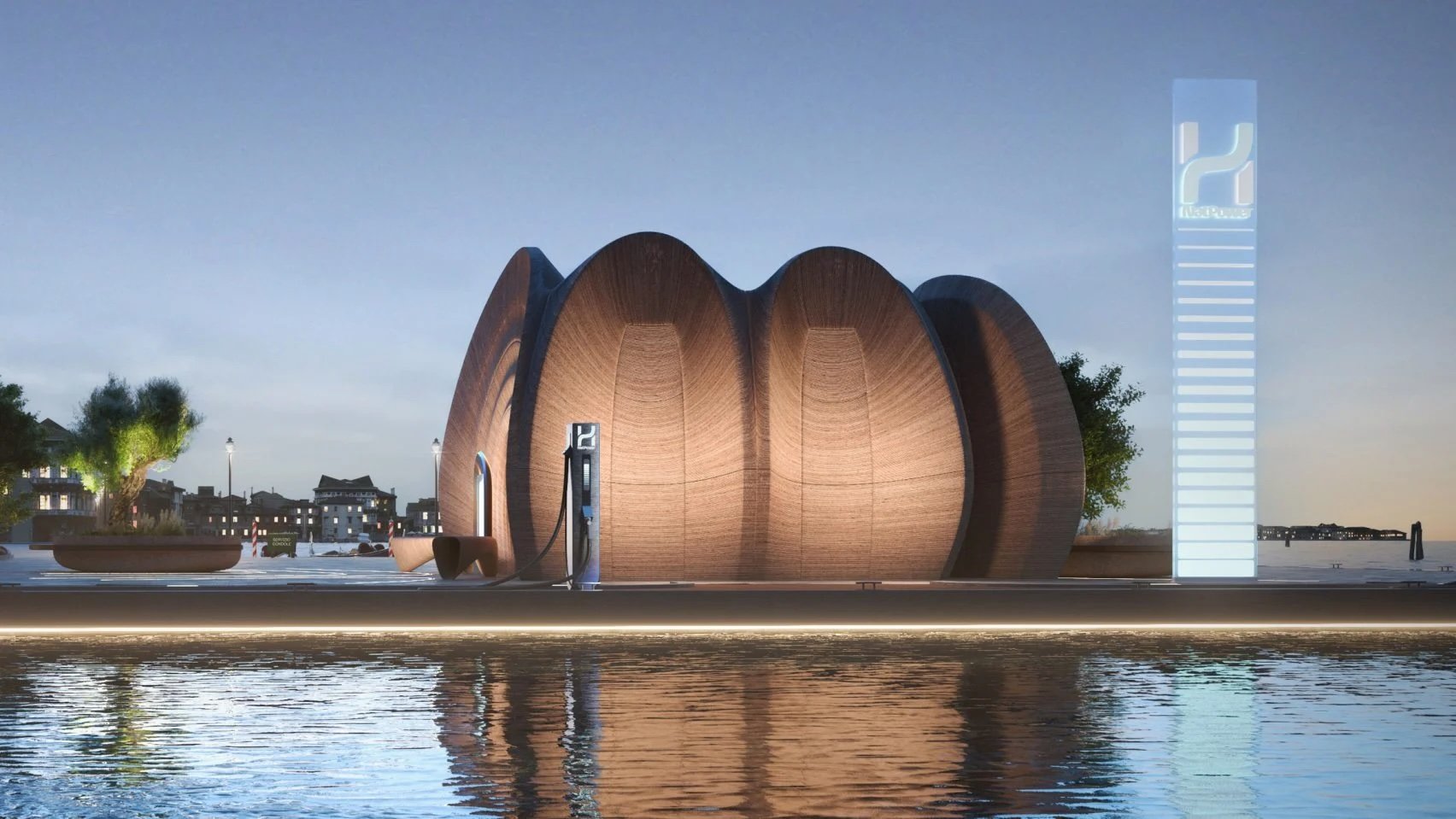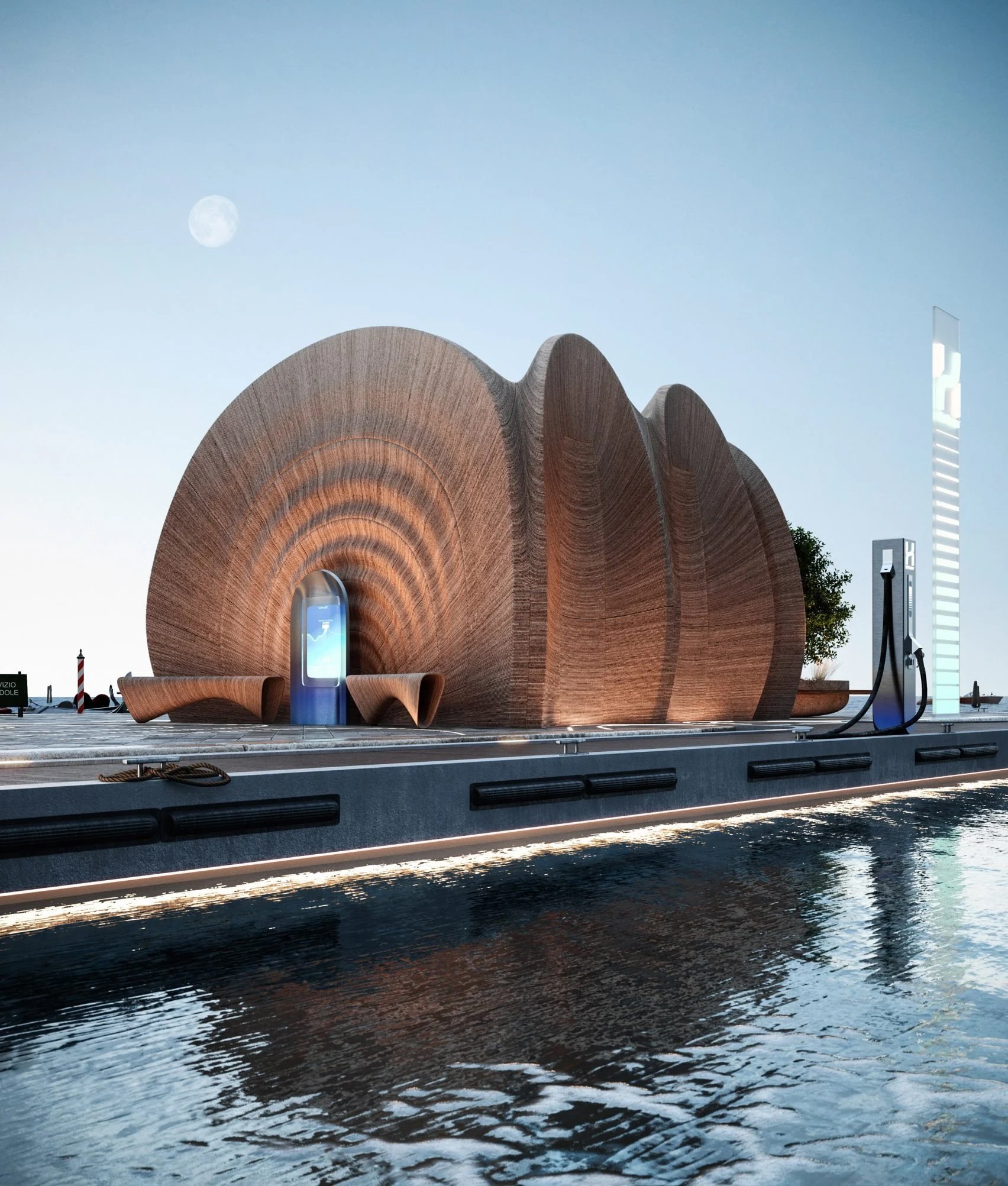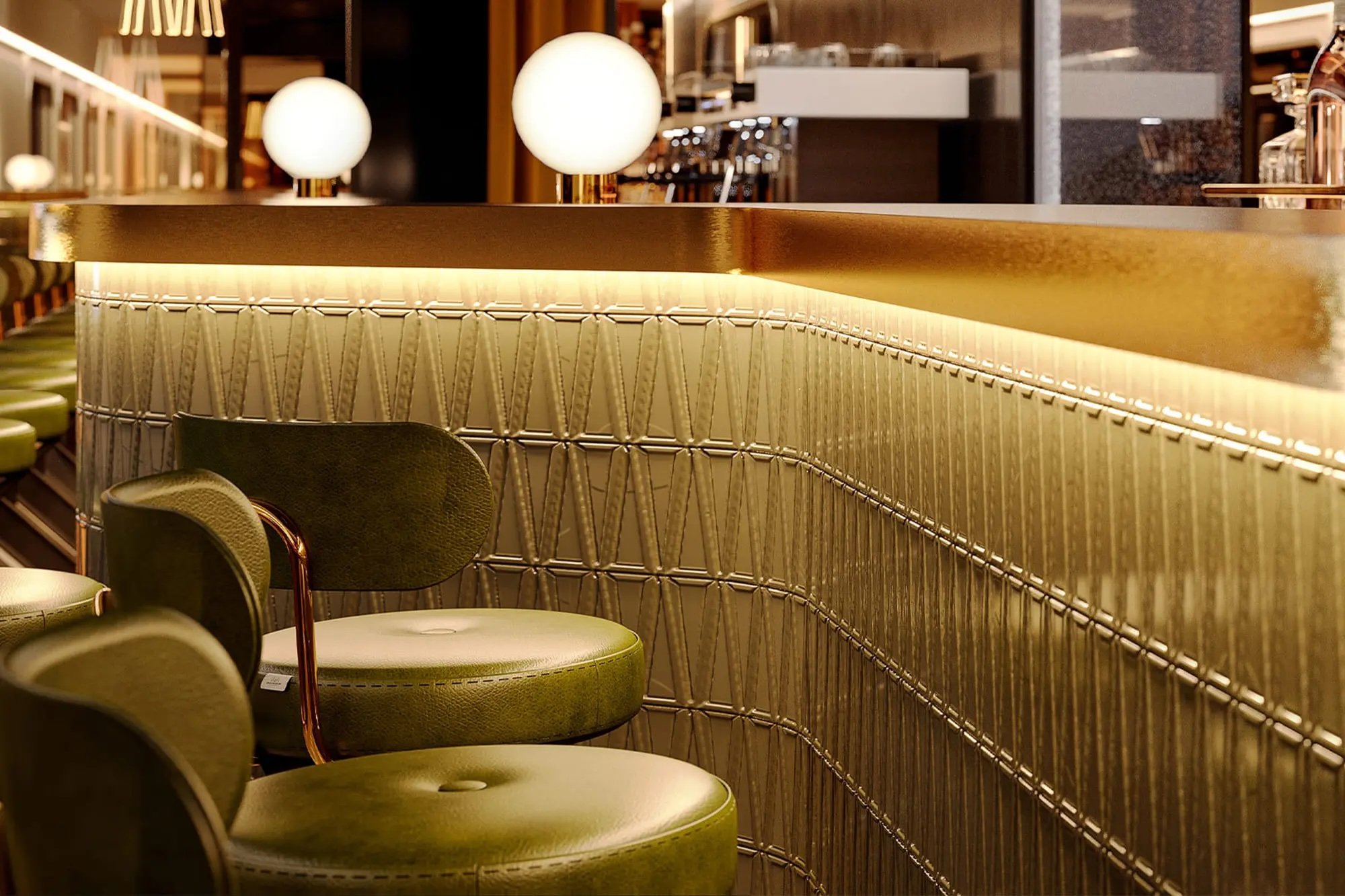How do you make sustainable travel super-attractive? You sculpt hydrogen refuelling stations, and redesign the classic train journey
Interior of the new Orient Express (from WorldCrunch)
We track design because we feel that the deep changes that eco-civilisation demands of people could be bridged by attractiveness and beauty. So we track the possibilities of the second term in George Monbiot’s axiom, “private sufficiency, public luxury”, as carefully and open-mindedly as we can. Who know where the transforming move will come from?
Two examples of this here. First, reported by Dezeen, comes from Italy:


British studio Zaha Hadid Architects is creating 100 refuelling stations in Italian marinas for energy company NatPower as the "world's first green hydrogen refuelling infrastructure".
Designed to be used by recreational boats, the refuelling stations by Zaha Hadid Architects (ZHA) will supply green hydrogen – a type of hydrogen produced using renewable energy.
The first charging station is set to be installed this summer, with 100 planned to be built in 25 Italian marinas and ports by 2030 funded by a €100 million investment led by NatPower H, which is part of energy company NatPower.
The charging stations form part of an effort to encourage the adoption of boats powered by green hydrogen for short trips. Hydrogen can be used to generate electrical power in a fuel cell, emitting only water vapour and warm air – unlike polluting combustion engines.
"Installing the infrastructure to deliver green hydrogen, NatPower H aims to create a network of sustainable energy hubs in all major Italian marinas and establish ideal conditions to facilitate the ongoing development and use of hydrogen-powered vessels," the studio said.
According to the studio, the 100 stations could eliminate approximately 45,000 tonnes of greenhouse gas emissions from the area's recreational boats each year.
The stations will each be divided into eight curved bays and made from 3D-printed concrete blocks with a layered composition designed to echo geometrics found in marine life.
According to the studio, the 50-square-metre stations will be fully recyclable and built from dry-assembled sections to minimise construction waste.
"Built with low-carbon concrete, the structural strength of ZHA's hydrogen refuelling stations is generated through geometry rather than an increased use of materials," Zaha Hadid Architects director Filippo Innocenti said.
"Integrating the latest innovations in construction techniques with the historic engineering developed throughout the Mediterranean by the Romans more than 2,000 years ago, the stations use advanced circular building technologies, reflecting NatPower H's commitment to an ecologically responsible future."
And from WorldCrunch, a piece on how luxury detail is wooing hi-end flyers away from their toxic planes, and towards train travel:
If rail is to become the preferred means of transport, it must inspire people to dream again. Designers and interior architects are on a mission to restore the image of rail travel. High-speed rail, night trains, luxury trains — each has its own challenges.
…Last summer, France's national railway company, SNCF, handled a record 24 million passengers. In 2022, night trains saw an 149% increase, according to a Trainline survey with YouGov.
“We’re clearly at a turning point. The train is a positive link in the evolution of our society, but we’re going to have to make people want to go back on it,” said Julien d’Hoker, founder of the Yellow Window design agency specializing in mobility. In addition to ticket prices, one of the major challenges is to make slowness desirable, in contrast to the race for speed of recent decades. Design thus becomes a central tool.
“We’re seeing the arrival of start-ups and new concepts that are dusting off the railway sector and allowing designers to express themselves the way they’ve wanted to do for years,” d’Hoker said.
At SNCF, design has always been at the core of major developments. In the 1970s, the company began collaborating with Roger Tallon, a visionary with a passion for high-speed rail travel, who was to play a decisive role in railway design in France. He worked on the concepts for the Corail trains, the TGV duplex and even the Eurostar. He created revolutionary new layouts, such as the various living areas within trains, with lounges for young people, business travelers and dining cars.
His forward-looking vision still resonates today. In the early 2000s, the SNCF collaborated with fashion designer Christian Lacroix to dress the TGVs. Although most passengers remember the flashy new seat colors, Lacroix also contributed to the evolution of the shape of the seats, the practicality of the carriages, with luggage racks in the center of the cars, and the lighting, with blinds to replace the curtains.
Today, giving a train a new look goes beyond comfort and aesthetic; designers have to create a new way of traveling.
While for some, designing a train interior is a childhood dream, everyone agrees that the challenge is immense. The constraints cannot be ignored for style or decorative whimsy. The specifications are heavy and complex.
“Designing the interior of a train is a mix of simplicity and ergonomic intelligence. Practicality makes for a successful and exceptional experience. The passenger must not suffer due to poor design,” says Tristan Auer, designer of Grand Suites for the luxury hotelier Belmond's Royal Scotsman train.
Designers have to adapt to a host of norms, take into account safety, ergonomics, durability, maintenance, accessibility and acoustics, all while initiating a new dynamic. For Maxime d’Angeac, artistic director of the new Orient Express, “It’s a very complex exercise. It’s not the work of a decorator, but of extremely advanced global design, and we cannot make mistakes. A train like the Orient Express isn’t just beautiful, it’s detailed, precise and masterful. There are no gratuitous sets, everything has a function and has to work.”
The train is also an enclosed space where people have to live together in harmony. Activities, behaviors and desires have evolved considerably: “The train is a shared living space in which you can create your own bubble, like a second home, or converse with your neighbors — that’s the designer’s challenge,” d’Hocker said.
The SNCF is taking the subject head-on, making design an emblematic marker. “We need to think globally about today’s challenges. The scale of the task is enormous,” said Florence Rousseau, Marketing Director of TGV Inoui 2025. A few weeks ago, the public company unveiled the interior design of the future Inoui TGVs, created by the renowned Japanese design studio Nendo and Arep, a French agency with expertise in mobility (see below).
Their reinterpretation focuses on a qualitative, gentle and poetic on-board experience. “The train is not just another mode of transportation, it’s an office, a bedroom, a dining room and a meeting place all in one. The idea here is to create gentle bubbles and showcase the landscape, so that passengers forget they're in a confined space,” said Isabelle Le Saux, design director of SNCF Voyageurs.
“Discretion and timelessness, the hallmarks of the Nendo studio, are also essential because these trains must last 40 years or so,” Rousseau said. A great deal of attention has been paid to the new hyper-functional seats, featuring innovative foam covered with a 3D knitted fabric made from natural fibers. It produces a hammock effect, conforms to the shape of the back and adapts to all morphologies.
A new, rounded lemon-yellow table lamp echoes a more familiar, domestic ambience, taking us away from the railway world. The designers have also completely redesigned the bar to make it “the jewel of the on-board experience," Rousseau said.
The return of night trains is also a major contemporary concern, as they are a serious alternative to medium-haul flights. Two young entrepreneurs, Adrien Aumont (co-founder of KissKissBankBank) and Romain Payet, have taken on the challenge of reviving the night train's image by creating Midnight Trains "hotels on rails".
These trains, which will link Paris to a dozen major European cities from 2025, aim to be an option more in tune with the times, far removed from the off-putting image of sleeper trains. “If we want people to get off planes, train travel has to be very desirable. We don’t believe in punitive ecology, we want to offer a new formula that will appeal to even the most reluctant," Payet said.
Inspired by the codes of the hospitality industry, these trains feature private rooms, a real restaurant, whose menu has been devised by a pillar of Parisian bistronomy, and a cocktail bar. The entry-level price for a night in a Japanese capsule-style room is equivalent to the price of a low-cost airline ticket.
Julien d’Hoker, who oversees the design and interior layout of Midnight Trains, has created a warm, hushed atmosphere, focusing “on luxury sensations rather than ostentation”, as Midnight Trains aims to revolutionize the sleeper train experience while remaining accessible.
To write the new history of the legendary Orient Express, which first entered service in the 1920s and is now owned by Accor group, Maxime d’Angeac designed a showcase of extreme luxury, embellished by the talents of the finest French craftsmen, just as it was originally adorned with Morrison marquetry and Lalique panels.
Scheduled to go into service in 2026, this train promises a timeless journey. In the meantime, impatient passengers will be able to board other Orient Express La Dolce Vita trains crossing Italy from November 2024 onwards. Their flamboyant interiors, imagined by Dimore Studio, one of Milan’s hottest design agencies, celebrate the golden age of Italian design in the 1960s and 1970s with a cinematic décor.
Railroad historian Clive Lamming is however more skeptical about the railway’s return to favor—and above all, mass appeal: “I think it’s going to be difficult to get people back on the train in large numbers. Particularly in rural areas, where stations have disappeared and users prefer the more convenient and comfortable car. It’s not enough to change the color of a train and the quality of the coffee, except for a limited clientele of bobo travelers."
So, it’s up to these talented designers, to paraphrase SNCF’s famous slogan, “to make you prefer the train”.
More here




